
Cash transfers are a promising tool to reduce intimate partner violence, but can they be effective across diverse contexts and programme design?
Intimate partner violence (IPV) is the most pervasive form of violence globally, with one in three women physically or sexually abused by a partner in her lifetime (Devries et al. 2013). IPV has multiple malign consequences for the physical and mental health of women, as well as a range of adverse effects on their children. While these consequences are well documented, there is less evidence on the effectiveness of policies and programmes in reducing IPV in the developing world.
Drawing mainly from Latin America, several recent studies find evidence that cash transfer programmes, targeted primarily at women, can reduce IPV. Given that cash transfer programmes are widespread around the world – implemented in over 130 countries and reaching approximately 718 million people globally (World Bank 2015) – they represent a promising, scalable, globally-relevant approach to reducing IPV. However, important questions remain as to whether policymakers can generalise the existing findings to diverse settings and whether these programmes provide a sustainable approach for IPV prevention.
Three case studies
Over the last 20 years, the International Food Policy Research Institute (IFPRI) has conducted numerous randomised evaluations of cash transfer programmes throughout the developing world. Although reductions in IPV have not been the main focus of these programmes or their evaluations, recently researchers have begun studying the unintended impacts of cash transfer programmes on IPV. We present findings from several recent IFPRI studies. We identify three policy-relevant knowledge gaps related to the potential of transfer programmes to reduce IPV, then address them drawing on case studies from three countries around the globe: Ecuador, Bangladesh, and Mali.
First, we note that transfer modalities other than cash, such as food and vouchers, are widespread around the world. These alternative modalities may serve some objectives better than cash, raising the question of whether there is a trade-off to using these modalities in terms of IPV impacts. The first case study in Ecuador asks the following question:
- Does the modality of transfer provided – food, cash, voucher – matter for impacts on IPV?
Second, most cash transfer programmes do not continue indefinitely. If these programmes are to be a sustainable solution to reducing IPV, their impacts must persist after the programmes end. However, there is little rigorous evidence on the post-programme impacts of cash transfers on IPV. Moreover, many cash transfer programmes in the developing world include complementary programming such as training, but much of the evidence showing that cash transfer programmes reduce IPV has been unable to distinguish the roles of these components. Given that the complementary programming may be logistically challenging and costly to implement, it is important to know if it is required for reductions in IPV. The second case study in Bangladesh asks the following question:
- What happens to IPV after a transfer programme ends, and does it depend on complementary activities provided along with transfers?
Lastly, much of the evidence on cash transfers and IPV focuses on programmes targeted to women in monogamous households. However, in some regions, targeting women may be viewed as contextually inappropriate. In parts of the developing world, particularly in Africa, diverse household structures such as polygamy are also common. The third case study in Mali asks the following question:
- What are the impacts on IPV when cash transfers are targeted primarily to men, and does it depend on household structure?
The programmes
The transfer programmes assessed in these three studies focused on household food security and child nutrition as primary objectives. However, the programmes differed in terms of scale, target population, duration, transfer amount, transfer frequency, recipient, and complementary activities (see Table 1). The programmes in Ecuador and Bangladesh were small-scale pilot programmes implemented by the World Food Programme and had female recipients – designated adult women in Ecuador, and mothers of young children in Bangladesh. The programme in Mali was a large government-implemented national cash transfer programme whose recipient was the household head, usually male. All programmes included complementary trainings on nutrition and other topics, but without any explicit focus on gender or violence. In Bangladesh, these trainings were part of a more intensive nutrition behaviour change communication (BCC) component.
Table 1 Cash transfer programme design
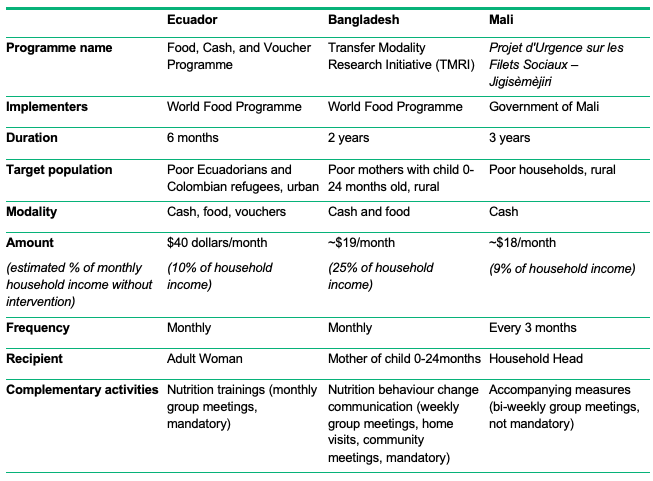
Study designs
Each case study draws on a cluster-randomised control trial to measure the causal impacts of the transfer programme on IPV, and mixed methods to understand what happens and why. All studies use the WHO Violence Against Women instrument (Ellsberg and Heise 2005) to measure IPV which was administered following the WHO protocol on ethical guidelines for conducting research on women’s experience with IPV. Table 2 summarises key features of the case studies’ designs.
Table 2 Study designs
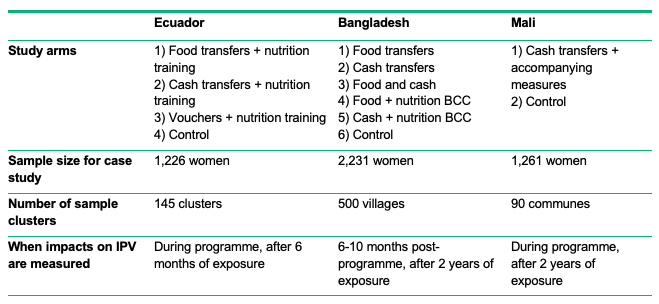
Results
1. Does the modality of transfer provided matter for impacts on IPV? (Ecuador)
No, the modality of the transfer provided did not matter for impacts on IPV. All three modalities – food, cash, and voucher – led to significant reductions of 25-35% in physical violence (Hidrobo et al. 2016).
Figure 1 Impacts on physical violence: Ecuador case study
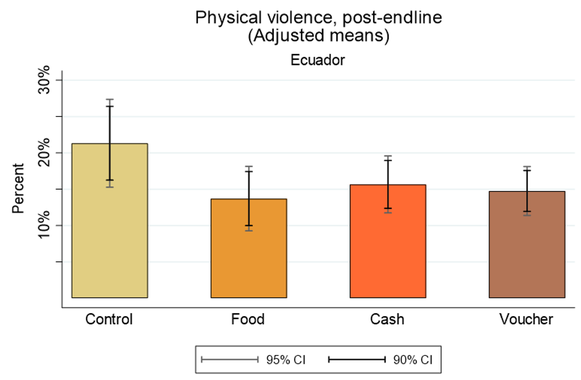
Note: Outcome variable is the adjusted mean prevalence of any physical and/or sexual violence in the last six months, calculated from the marginal effects of probit models. Standard errors are clustered at the cluster level. Basic controls include baseline prevalence of physical violence and dummy for province stratum. (N=1,226).
Source: Hidrobo et al. (2016).
2. What happens to IPV after a transfer programme ends, and does it depend on complementary activities provided along with transfers? (Bangladesh)
Six to ten months after the programme ended, transfers + BCC led to a 26% reduction in physical violence, but there were no impacts from transfers only on IPV six to ten months post-programme. BCC was required to sustain the impacts of transfers on IPV (Roy et al. 2018).
Figure 2 Impacts on physical violence: Bangladesh case study
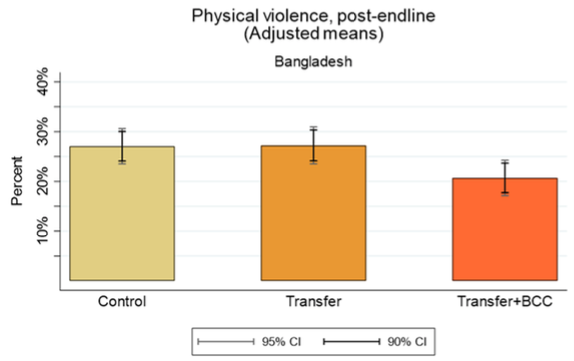
Note: Outcome variable is the adjusted mean prevalence of any physical violence in the last six months, calculated from the marginal effects of probit models. Standard errors are adjusted for clustering. Extended controls include baseline characteristics of woman and husband. (N=2,231).
Source: Roy et al. (2018).
3. What are the impacts on IPV when cash transfers are targeted primarily to men, and does it depend on household structure? (Mali)
Impacts depended on household structure. Cash transfers led to a 41% reduction in physical violence in polygamous households, but they had no impact on monogamous households (Heath et al. 2018).
Figure 3 Impacts on physical violence: Mali case study
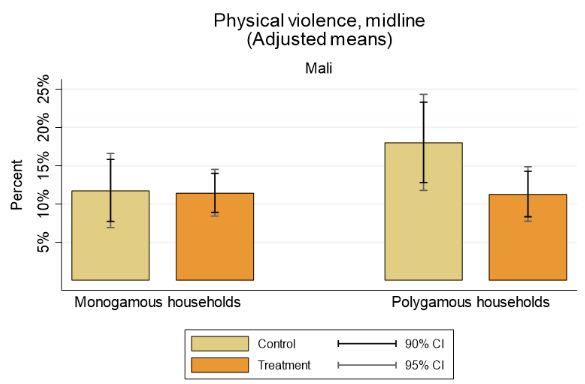
Note: Outcome variable is the adjusted mean prevalence of physical violence in the last 12 months. Standard errors are adjusted for clustering. Extended controls include baseline characteristics of woman and husband. (N=1,261).
Source: Heath et al. (2018).
Mechanisms
There are three pathways outlined in Buller et al. (2018) through which cash transfers can affect IPV.
- The first is through economic security and emotional wellbeing, whereby cash improves a household’s financial situation, which reduces poverty-related stress and improves members’ emotional wellbeing, reducing men’s triggers for perpetrating IPV.
- The second is through intra-household conflict, whereby cash may decrease or increase arguments and resulting conflict over the spending of money.
- The third is through women’s empowerment, whereby cash targeted to women and complementary activities may increase a women’s bargaining power, making them less willing to accept violent behaviour.
Across all three studies, we find evidence of one or more of these three pathways. Economic security and household wealth increased in all three case studies. In Mali where we specifically measure emotional wellbeing, we also find reductions in stress and anxiety among men in polygamous households. Intra-household conflict appears to decrease in all three case studies. Quotes from Ecuador and Bangladesh suggest that conflict decreased because women no longer had to ask their husbands for daily money to buy food (Buller et al. 2016, Roy et al. 2018), and in Mali we find larger decreases in reported disputes among polygamous households than among monogamous households. Women’s empowerment improved in both Ecuador and Bangladesh with evidence of increased control over money, agency, and social capital. However, we find no evidence of improvement in Mali, which is unsurprising given that the transfer was not targeted to women.
Policy implications
Despite diverse programme features and contexts, we find commonalities across the three case studies. First, cash transfers reduce IPV in all three case studies, even though IPV was not the main focus of any programme. Second, although there is theoretical potential for cash transfers to increase IPV, we do not find any evidence that the transfers increased IPV in these three studies.
In terms of programme design, we find that the transfer modality does not matter for impacts on IPV, but complementary activities may be essential for sustaining impacts. Transfers targeted to men rather than women still have the potential to reduce IPV through improvements in economic security and reductions in intra-household conflict, but impacts depend on context and household structure.
Overall, these case studies show that cash transfers are a promising tool to sustainably reduce IPV throughout the developing world, but nuance is required in considering programme features and context. Features and contexts of programmes affect the pathways through which cash transfers affect IPV, and impacts on IPV may revert if the cash transfer programme does not sustainably affect the pathways.
Authors’ note: The studies were carried out by researchers at IFPRI in collaboration with researchers from Cornell University, University of Washington, the London School of Hygiene and Tropical Medicine, Johns Hopkins Bloomberg School of Public Health, and the UNICEF Office of Research—Innocenti. This work was undertaken as part of the CGIAR Research Programme on Policies, Institutions, and Markets (PIM) led by the International Food Policy Research Institute (IFPRI).
References
Buller, A, M Hidrobo, A Peterman and L Heise (2016), "The way to a man’s heart is through his stomach?: A mixed methods study on causal mechanisms through which cash and in-kind food transfers decreased intimate partner violence", BMC Public Health 16(488), 1–13.
Buller, A, A Peterman, M Ranganathan, A Bleile, M Hidrobo and L Heise (2018), "A mixed-method review of cash transfers and intimate partner violence in low- and middle-income countries", World Bank Research Observer.
Devries, K, J Mak, C García-Moreno, M Petzold, J Child, G Falder, S Lim, L Bacchus, R Engell, L Rosenfeld, C Pallitto, T Vos, N Abrahams, C Watts (2013), "The global prevalence of intimate partner violence against women", Science 340(6140).
Ellsberg, M and L Heise (2005), "Researching violence against women: A practical guide for researchers and activists", Geneva: World Health Organization, PATH.
Heath, R, M Hidrobo and S Roy (2018), "Cash transfers, polygamy, and intimate partner violence: Experimental evidence from Mali", IFPRI Discussion Paper, 01785.
Hidrobo, M, A Peterman and L Heise (2016), "The effect of cash, vouchers, and food transfers on intimate partner violence: Evidence from a randomised experiment in Northern Ecuador", American Economic Journal: Applied Economics, 8(3).
Roy, S, M Hidrobo, J Hoddinott and A Ahmed (2018), "Transfers, behaviour change communication, and intimate partner violence: Post-programme evidence from rural Bangladesh", Review of Economics and Statistics, In press.
World Bank (2015), "The state of social safety nets 2015", Washington, DC: World Bank.


